"We must be ready to dare all for our country. For history does not long entrust the care of freedom to the weak or the timid. We must acquire proficiency in defense and display stamina in purpose." - President Eisenhower, First Inaugural Address
Off the Deck

Thursday, August 31, 2006
Latest ONI World Wide Threat to Shipping (to 30 August 06)
Latest ONI World Wide Threat to Shipping (to 30 August 06) here.
U.S. Discusses Ballistic Missile Conversion with Russia
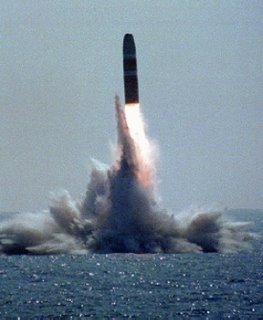
Interesting discussions: U.S. Discusses Ballistic Missile Conversion with Russia.
The United States is considering plans to convert several of its existing long-range ballistic missiles to carry conventional explosives instead of nuclear warheads, allowing for rapid, pre-emptive strikes against terrorist targets anywhere in the world.. Related article here
Secretary of Defense Donald Rumsfeld spoke with reporters following a meeting with Russian Defense Minister Sergei Ivanov to discuss the proposal, as well as several other issues currently topping the U.S.-Russian security agenda.
“We don't know how the world's going to evolve,” Rumsfeld told reporters August 27 in Fairbanks, Alaska, “but we do know that there are terrorist networks in the world, and they are already using missiles,” referencing recent attacks on Israel by the Lebanon-based terrorist group Hezbollah. (See related article.)
The U.S. plan calls for the conversion of several of the Navy’s submarine-launched Trident missiles to meet emerging threats from terrorism or proliferation of weapons of mass destruction. As part of the United States' and Russia’s extensive nuclear security partnership, Rumsfeld suggested that Russia consider pursuing missile conversions as well.
Sea based X-band Radar stuck in Hawaii
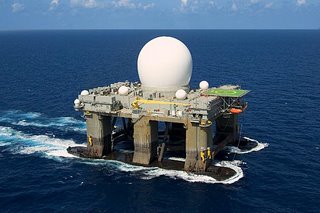
As reported here:
he giant radar, so powerful it can tell which way a baseball is spinning 3,000 miles away and so cutting edge it has been billed as the nation's best chance at comprehensive missile defense, came to the historic port of Pearl Harbor for what was advertised as a quick stopover for minor repairs and a paint job.Murdoc has links to more here.
That was eight months ago.
Now, even as the weeks pass and the price tag creeps toward $1 billion, the Sea-Based X-Band Radar shows little chance of actually making the voyage to its intended port in Alaska - considered the optimal location for monitoring potential North Korean missile launches - until at least later this fall.
Earlier post on offshore radar rigs here.
An on-line piracy attack map service

Reported by ICC Commercial Crime Services:
Sea captains and ship owners whose vessels must travel through piracy hotspots have a new tool to help them prepare their voyage. The International Chamber of Commerce’s International Maritime Bureau (IMB) has launched an online piracy map which gives users a visual on the nature and location of attacks to help them better understand and track incidents.Map site here.
The map is available as either a satellite view, provided by Google, a plain view (indicating countries and borders), or a combination of both. Viewers see not only the relief of the coastline but also the bays and coves from which pirates may initiate their attack.
“It is not easy to get an immediate picture of the piracy risk of an area by reading lengthy reports full of data and numbers,” said IMB Director Pottengal Mukundan. “We hope the map, coupled with the IMB Piracy Reporting Centre (PRC) alerts, will help seafarers spot the warning signs and better prepare for possible attacks.”
While the map is primarily aimed at helping ship owners, managers and their crews, Captain Mukundan noted that law enforcement officials will find it useful in deciding where best to concentrate their searches for pirates, and researchers will benefit from actually seeing the geographical circumstances of piracy attacks to predict trends.
***
This user-friendly map can be accessed on the IMB website (www.icc-ccs.org). Red balloons mark actual attacks while yellow balloons show attempted attacks. Clicking on these initiates a pop-up with a summary of the attack including the date and time, the type of vessel attacked, the type of attack and the number of crew affected.
No Chinese investment in Indian ports
India govt decides not to allow Chinese cos to invest in ports:
The government has decided not to allow any Chinese company to invest in or manage any Indian port due to security concerns, the Times of India reported, citing unnamed sources.
The decision shuts the door on Hong Kong-based Hutchison Port Holdings (HPH), which has been waiting for security clearances to go ahead with bids to build container terminals in Bombay (Mumbai) and Chennai, the newspaper said.
Blackwater goes maritime
Reported here:
Blackwater, a training, security, logistics, peace support, and stability operations firm unveiled its plans to create a new subsidiary; Blackwater Maritime Security Solutions. Blackwater Maritime Security Solutions (BMSS), in a strategic partnership with the Global Maritime and Transportation School (GMATS) at the U. S. Merchant Marine Academy, and other professional maritime organizations and industry leaders will focus on providing world-class tactical maritime security training, professional maritime security services, and cutting-edge maritime security vulnerability assessments and plans in accordance with the International Maritime Organization (IMO)-mandated International Ship and Port Facility Security (ISPS) code.Blackwater's site.
***
BMSS will also provide international anti and counter-piracy, and anti and counter-terrorism security programs led by the world’s finest maritime special operations and security professionals. BMSS will soon offer its complete tactical maritime security training services aboard fully operational maritime platforms.
Sixth Japanese Aegis launched

From here:
The Maritime Self-Defense Force launched its sixth Aegis destroyer at a Wednesday ceremony in a dockyard in Nagasaki as part of Japan's plan to add sea-borne antimissile capabilities.
***
The government plans to fit the six Aegis destroyers with the SM-3s, which are capable of intercepting ballistic missiles.
Wednesday, August 30, 2006
Glenn Ford, Capt, USNR (ret) dies

Movie Actor Glenn Ford dies at 90 . His acting biography here. His military biography here:
Ford interrupted his film career to volunteer for duty in World War II with the United States Marine Corps Reserve on December 13, 1942. He was assigned in March 1943 to active duty at the Marine Corps Base in San Diego. He was sent to Marine Corps Schools Detachment (Photographic Section) in Quantico, Virginia, three months later, with orders as a motion-picture production technician. Promoted to sergeant, Ford returned to the San Diego base in February 1944 and was next assigned to the radio section of the Public Relations Office, Headquarters Company, Base Headquarters Battalion. There he staged and broadcast the radio program Halls of Montezuma. Ford was honorably discharged from the Marines on December 7, 1944 for duodenal ulcers that had him hospitalised for several months.[7]One of my favorite actors. Rest in peace.
In 1958, he joined the U.S. Naval Reserve and was commissioned as a lieutenant commander and made a public affairs officer. During his annual training tours, he promoted the Navy through radio and television broadcasts, personal appearances, and documentary films. He was promoted to commander in 1963 and captain in 1968.
Ford went to Vietnam in 1967 for a month's tour of duty as a location scout for combat scenes in a training film entitled Global Marine. He traveled with a combat camera crew from the demilitarized zone south to the Mekong Delta. For his service in Vietnam, the Navy awarded him a Navy Commendation Medal. His World War II decorations are as follows: American Campaign Medal, Asiatic-Pacific Campaign Medal, World War II Victory Medal, Rifle Marksman Badge, and the US Marine Corps Reserve Medal. He retired from the Naval Reserve in the 1970s at the rank of captain.[8]
UPDATE (2013): Revised. The original contained information that apparently confused Mr. Ford with director John Ford. I regret the error.
Training baby helicopter pilots
Before they hit the fleet, they land 
here:
I wonder if the skipper of IX-514 is a carrier qual'd Nasal Radiator...
UPDATE: More on IX-514, "the Navy’s smallest training aircraft carrier" here.

here:
A TH-57 training helicopter from Helicopter Training Squadron Eight at Naval Air Station (NAS) Whiting Field, flown by student pilot Navy Lt. j.g. David Dostal and instructor Navy Lt. Teresa Ferry lands on the Navy Helicopter Landing Trainer (HLT) IX-514, marking the 100,000th consecutive accident-free landing aboard HLT IX-514. U.S. Navy photo by Gary Nichols100,000 is a big number.
I wonder if the skipper of IX-514 is a carrier qual'd Nasal Radiator...
UPDATE: More on IX-514, "the Navy’s smallest training aircraft carrier" here.
Watching North Korea - using seismic tools
It's not unique, but it's interesting that it got covered as reported here:
A normally unburdened South Korean earthquake center has become the front line of the world's vigil for North Korea's first nuclear test, monitoring the peninsula's geological pulse with seismic sensors and sound detectors.Did you know the Univeristy of Hawaii operates an Infrasound Laboratory ("ISLA")?
***
On Monday, the head of South Korea's intelligence agency, Kim Seung-kyu, said the North was ready to test a nuclear device at any time, but there was no direct sign that the communist nation was preparing a detonation.
Still, the South Korean center remains on the lookout using two methods: infrasound and seismic waves.
The most reliable means of confirming a nuclear test would be from infrasound -- ultralow noises from an explosion below the range of human hearing.
At ISLA our primary mission is to operate listening stations as part of the International Monitoring System of the Comprehensive Nuclear-Test-Ban Treaty. We also conduct research into acoustic source processes, propagation, instrumentation, signal and array processing, and software development.
USS Shiloh (CG-67) deploys to Japan with some fanfare

Reported here, a help in dealing with the DPRK:
"She (the Shiloh) complements the state of the art X-band radar just installed in northern Japan and the U.S. Patriot Advanced Capability-3 missiles arriving in Okinawa," said Joseph Donovan, deputy chief of mission at the U.S. Embassy in Tokyo, at the arrival ceremony at the base.Interesting press coverage. Sending a message?
Tokyo and Washington are proceeding with setting up a two-step missile defense system in Japan in which an incoming ballistic missile is first dealt with by firing SM-3 interceptors from Aegis ships at sea and, if that fails, firing PAC-3 missiles from the ground.
The Shiloh deployment follows North Korea's test-firing of seven missiles, including a Taepodong-2, on July 5.
The two-stage version of Taepodong is believed to be capable of reaching Guam, Hawaii, Alaska and the U.S. West Coast; a three-stage missile could target all of North America.

Shiloh Photo: U.S. Navy photo by Mass Communication Specialist 2nd Class Chantel M. Clayton
SM-3 launch: US Navy photo
Singapore practices maritime security


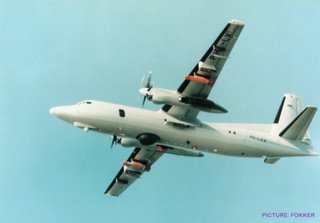
Reported here:
...[S]ome 1,600 personnel from the city state's Air Force and the Army, as well as the Police Coast Guard (PCG), Maritime Port Authority (MPA), and the Immigration and Checkpoints Authority (ICA), are participating in the exercise, code-named Exercise APEX 06.Practice makes... better.
Some Singapore Navy's mine countermeasures vessels and Fokker 50 maritime patrol aircraft, as well as boats from the above- mentioned agencies were also involved in the annual drill...
Various scenarios played out in the exercise included the disposal of a sea mine detected in the Singapore Straits by the country's mine-hunting assets, as well as a ferry mishap which required co-ordinated responses by different agencies to handle various consequence management issues, such as evacuation and medical aid for casualties, according the Defense Ministry.
On the Singapore mine hunting ships:
These Swedish-designed Landsort class MCMVs belong to the 194 Squadron. They are equipped with remotely operated Mine Disposal Vessels MDVs which are capable of detecting, locating, identifying and destroying modern sea mines. Their weapons onboard include the 40 mm BOFORS Gun and the CIS 0.5" Machine Gun.(source)Aircraft is Fokker-50.
UPDATE: Maybe there's a reason for some practice. See here:
Singapore will deploy at least 10,000 personnel to prevent terrorist attacks and illegal protests at next month's International Monetary Fund and World Bank meetings in the city's biggest-ever security operation.Will they be barring Reuters, then?
National servicemen have been called up, the coastguard will increase searches of ships and helicopters will report on illegal assemblies, Senior Assistant Commissioner of Police Aubeck Kam told reporters today. Certain ``troublemakers'' known to international authorities may be barred from entering Singapore altogether, he said.
Tuesday, August 29, 2006
Bombing suspects nabbed in Philippines
Reported here:
Military agents nabbed at Polloc Port in Parang, Maguindanao over the weekend three suspected bombers believed to be members of the Abu Sayyaf terror group, a belated military report here said Tuesday.No comment.
Arrested while boarding the Manila-bound Superferry 16 passenger ship on August 27 were Razak Macarimbang, Wahad Sandigan and Sammy Gampong, all residents of Maguindanao province.
Seized from the trio were two homemade bombs supposedly to be used in a bombing mission in Metro Manila in exchange for money.
"The Army's 6th Infantry Division (6ID) is presently interrogating the suspects as the group reportedly plans to sow terror across the country," 6ID spokesman Lt. Col. Julieto Ando said in an interview.
Admitting that one of the arrested suspects belongs to their organization, Von Al-Haq, chair of the Moro Islamic Liberation Front's Coordinating Committee on the Cessation of Hostilities, said they have filed a protest over the military's violation of their existing bilateral ceasefire agreement.
"We have witnesses who can attest that the three were framed up and the pieces of evidence recovered from them were planted," Al Haq said.
In a separate interview, MILF spokesman Eid Kabalu clarified that there were no orders from the MILF leadership to stage bombing activities in Metro Manila in exchange for money.
"We are not terrorists but a revolutionary group trying to iron out peace matters with the government," he emphasized.
Tuesday reminder: Fred Fry's Maritime Monday
Look, it's good for a week - go visit Fred Fry International: Maritime Monday 24. It's free!
Latest piracy report from ICC CCS (to 28 August 06)
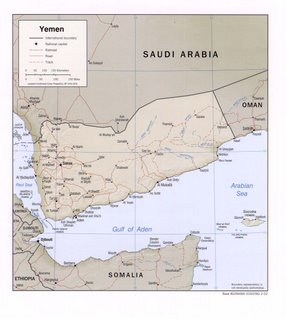
Latest ICC Commercial Crime Services Piracy Report (to 28 August 06) here. Highlight:
27.08.2006 0045 LT in posn: 13:15.5N - 047:13.2E, Gulf of Aden.Also Vietnamese/Cambodian fishing piracy action. Speaking of which, the fun continues as Cambodia promises to investigate Vietnam's assertion that some Cambodian coast guardsmen were acting piratical here:
Two speedboats approached a bulk carrier underway. Crew mustered, took anti piracy measures. Fifteen minutes later boats moved away. A second attempt was made at 0430 LT when several speed boats approached the vessel and followed for 40 minutes but due to anti piracy measures boats aborted attempt and fled.
Two Cambodian officials pledged Tuesday to investigate Vietnam's accusations that four members of the Cambodian coast guard were caught in acts of piracy on Vietnamese fishing boats. Police General Touch Vorleak, coast guard chief in the southeastern Cambodian province of Kampot, and Kampot provincial governor Thach Khorn each said they would launch investigations into Vietnam's arrest last week of four heavily armed Cambodians accused of commandeering Vietnamese fishing boats.And another claim of of "foreign men" attacking Vietnamese fishermen here:

A group of unidentified foreign men launched a surprise attack on a Vietnamese fishing boat and stole their entire cuttlefish catch, a local source reported Tuesday.Better make sure your cuttlefish are not of the pirated variety.
The boat’s captain Le Van Dung told police on the phone that the attack had taken place near Bong Bay Island off the central Danang city with the pirates forcing his crew to move 2.5 tons of cuttlefish to their boat.
UPDATE:

Valuable cuttlefish information (for free!) here, "Cuttlefish are much more closely related to garden slugs and snails than they are to fish! "
Gadzooks.
Japan enforces EEZ- arrests S Korean fishing boat for being over the limit
Reported here:
A patrol ship of the agency's regional office carried out on Sunday evening an on-board inspection of the fishing boat on the Sea of Japan at about 375 kilometers northwest of Sado Island, and found out that its catch in the five days beginning Aug. 23 was 17, 397 kg, nearly four times of the amount it logged, the agency said.
According to Japanese regulations, fishing boats from South Korea can operate in Japan's EEZ after obtaining permission, but have to log their catches accurately.
Monday, August 28, 2006
Somalia: Mogadishu port receives first ship in 10 years

The newly reopened Mogadishu port took in its first ship in 10 years as reported here:
A ship has docked at the main port in Somalia's capital, Mogadishu, for the first time in more than 10 years.
Hundreds of people went to the port to see the ship, which arrived from Kenya carrying goods such as TVs and coffee.
In other events, an official with the Islamist Courts Council warned journalists:
A top official with the Islamic Courts Council has threatened local media with unspecified measures against any journalist whose reports about Islamist activity are "exxagerated."UPDATE: Besides making the trains run on time -- I mean- opening the port and stifling Somali piracy, Daveed Gartenstein-Ross at The Counterterrorism Blog sees a "New Taliban" with al Qaeda links and more bad news here and at the Daily Standard piece linked there.
Yusuf Mohamed Siad "Indha Ade," the self-declared governor of Lower Shabelle region, declined to give details of exactly what the ICC considers "exxagerated" reporting but his message to the local media was clear.
"We urge the media to not exxagerate events, and we warn you [the media] because we will hold you to account," Indha Ade said. Aside from being a self-declared governor, Indha Ade is the Islamists' security chief.
There are parallels in history, none of them pleasant: I didn't expect a kind of Spanish Inquisition.
Sunday, August 27, 2006
China bolstering maritime rescue
Reported here, China working to improve its equivalent of the "Life Saving Service"
Bigger, faster, stronger: That is the plan for the updated offshore rescue system unveiled by China Rescue and Salvage Bureau yesterday.
Operational by 2010, the new system will mean rescue vessels will be able to reach any spot within 50 nautical miles (92.6 kilometres) of the coast in two and a half hours, cutting reaction time by an hour from present.
Helicopters will be able to search for and rescue targets at night, expanding the offshore search radius from 110 to 260 nautical miles (204 to 482 kilometres).
Also, rescuers will be able to salvage ships weighing 50,000 tons.
***
Started in 2004, the reform has so far seen good results. In May, the country's rescue workers saved more than 330 Vietnamese fishermen from the fury of Typhoon Chanchu.
The bureau dispatched four rescue vessels and one helicopter for the 17-day mission. They searched through an area of more than 200,000 square kilometres, and found 22 Vietnamese fishing boats.
Currently the bureau has 180 vessels and nine helicopters. More than 8,000 people are employed in 20 rescue bases along the coast.
In the past three years, the bureau has saved more than 9,000 people, including 1,362 foreigners.
It has helped at least 458 ships, including 85 foreign ships, out of danger.
Furthermore, the bureau has salvaged the wreckage of 33 sunken boats, including five foreign boats.
Sunday Ship History: USS Mount Hood (AE-11)
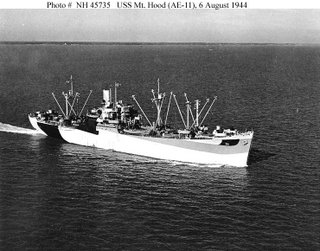
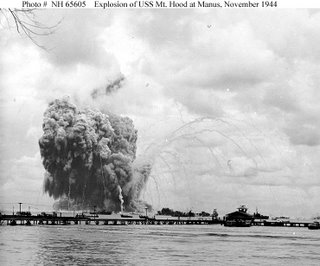
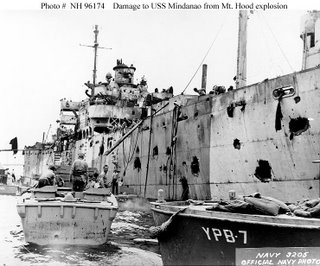

As I have noted before, the U.S. Navy rearms, refuels and resupplies at sea using a technique known as underway replenishment. Oil gets delivered by oilers, food and other stores by combat stores ships and ammunition by - ammunition ships.
Surprisingly, given their cargo, the safety record of these ammo ships has been pretty good. Sadly, however, their record is not perfect. During WWII, the Navy lost a couple of these ships including USS Mount Hood (AE-11). As set out here, AE-11 was built as a merchant hull and converted to an ammo ship:
Commissioned in July 1944, she transited the Panama Canal in August and was assigned to the South Pacific area to provide ammunition to the fighting forces. On the morning of 10 November 1944, while she was moored at the Manus Naval Base, Admiralty Islands, Mount Hood's cargo of explosives detonated in a massive blast. The ship was utterly destroyed by the accident, which killed all those on board her. Damage and casualties were also inflicted on ships anchored as far as 2000 yards away. Personnel casualties on Mount Hood and on other vessels totalled 45 known dead, 327 missing and 371 injured.Of course, there was an official Navy investigation (reported at this very good site) that suggests that the explosion was likely due to unsafe ammo handling procedures:
Since the possibility of enemy action appears to have been remote, the most probable cause of the accident was rough handling of the ammunition while loading or unloading. The propagation of the explosion was undoubtedly increased by inadequate separation and segregation of incompatible items in stowage. Evidence indicates the possibility of the detonation of TPX loaded depth bombs while it was being loaded into the number three or number four hold. Detonation could have been caused by striking the hatch with the bombs on the way down or dropping them into the hold carelessly.Given that no one on the ship survived, I suspect the list of causes was simply a generic list, the sort of things which could cause the explosion or slow the fighting of a fire if one began. However, as a former AE sailor, I can assure that the safe handling of ammo is not something you ignore.
The following unsafe conditions and practices were revealed by the investigation:
1. That ammunition was being roughly handled in all parts of the ship.
2. That boosters, fuzes, and detonators were stowed together in one hold in a manner contrary to regulations governing transportation of military explosives (USCG NavCG 108).
3. That broken rockets form which some of the powder was spilled had been stowed in two of the holds.
4. That safety regulations for handling ammunition were not posted in conspicuous places about the ship and there was a general lack of instruction to the crew in safety measures.
5. That pyrotechnics and napalm gel incendiaries were stowed in an open temporary wood and tar-paper hut on deck under hazardous conditions near the hatch to number four hold.
6. That there was evidence that fuzes, detonators, and other ammunition were accepted on board which were definitely defective and should have been destroyed or disposed of by dumping in deep water.
7. That the fire hose was not laid out. There was evidence that fire drills were infrequently held.
8. That there was a lack of enforcing the prohibitions of smoking in boats alongside the ammunition vessel.
As set out at the same site, some other eyewitness accounts include a submarine attack and an attack from the air. And there is this:
"For some unknown reason, Mt. Hood had been anchored in the midst of the ships of the Seventh Fleet Service Force. Casualties to other vessels would have been minimized if the ammunition ship had been spotted at an isolated location a few miles down harbor, off the ammunition supply depot at Lugos, the customary anchorage for ships of this type. Somebody was at fault for designating an anchorage for Mount Hood so near to the other ships."
It should be noted at a dozen or crewmembers did survive because they were off the ship:
Lieutenant Wallace, a Naval Reserve officer and a native of Atlanta, Georgia, recently was ordered back to this country. The only surviving officer of the Mount Hood, he told a few details of the explosion.It would only take one.
"I was the communications officer aboard the Mount Hood," he recalled. "I had to pick up some communications manuals and other publications at the base. Some enlisted men had dental appointments on the base, mail clerks had to pick up mail, so we all went in one boat.
"We went ashore about 0830 (8:30 A.M.) and were walking up the beach when a sailor, with a startled look in his eye, screamed: 'LOOK!', and pointed to seaward. There was a flash, followed by two quick explosions. We were knocked down, but scrambled to our feet and got back in the boat.
"We headed toward the Mount Hood. There was nothing but debris all around, so we returned and reported to the Commanding Officer of the base what we had seen, and helped him as much as we could in trying to find out what happened. I guess no one ever will know what really happened. She just blew. We had never had an explosion of any kind on the Mount Hood before that."
To the dead, the wounded and the brave men who continued to sail the ammo ships of WWII and the ones who have sailed them since, a salute.
Thought you might like to know.
UPDATE: Previous post mentioning the explosion at Port Chicago, California here.
Saturday, August 26, 2006
New (well, let's say up-sized) booby trap
Castle Argghhh!!! reveals a potentially deadly trap here.
Probably not safe for readers of the book Who Moved My Cheese?
Probably not safe for readers of the book Who Moved My Cheese?
Friday, August 25, 2006
Friday foolishness
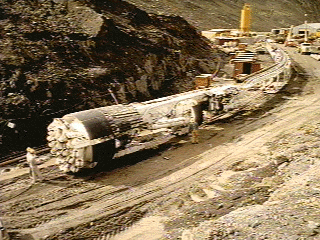
Putting on our Men in Black dark glasses, we see the Weekly World News has revealed another "stealth" program with its usual -er- reliability. Found here:
America's military arsenal includes a deadly new weapon: Submarine-like craft that travel underground instead of underwater!I hope the Iranians spend a good deal of effort looking for these machines.
Dubbed Subterranean Underground Vehicles, or SUVs, 14 of the top-secret vessels are already roving far beneath the sands of Iran, poised to launch a surprise attack if it becomes necessary to overthrow the rogue regime.
By the way, the photo has nothing to do with the article- at least I don't think it does... It's from here.
UPDATE:
 From here, though I think these guys are serious.
From here, though I think these guys are serious.
Somalia: Fishermen and chips

Four Thai fishemen supposedly were tossed overboard from their boat and rescued by Somali fishermen off the Puntland coast and now may be bargining chips in a bigger game. All reported here:
It is widely believed that the unnamed seamen will stay in Somali custody as a bargaining chip to negotiate the release of three Somalis from the Puntland region currently serving a three-year jail sentence for piracy in a Thai jail.Wow! You can't make stuff like this up. Unless you work for Weekly World News, which last week reported bin Laden being captured by rednecks. In Missouri.
***
"We were happy to hear of the rescue of the Thai sailors because their people wrongfully arrested our men who were on a Thai vessel that was hijacked by Somali pirates.
But the Thai government turned around and charged them as the pirates," said Rahma Ugas, a relative of one of the Somali men.
"If the Puntland administration tries to release the men, we will organise demonstrations and strikes."
Puntland authorities say the men may face illegal fishing charges before their case is referred to the families of the Somalis held in Thailand.
Stirring up Jihad
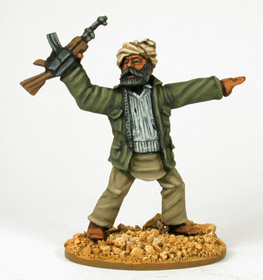
Smash has a post regarding the allegation that the KGB "armed and instigated radical Islamic terrorists" back in the 70's. I'm sure some will note with irony that the U.S. provided assistance to the Afghan mujahideen during the Russian incursion into Afgahanistan, a favor which, it is alleged, brought us Osama bin Laden and others of his camp (note: See comments - a disinction is being drawn between indigenous Afghan fighters who received U.S. aid and Afghan Arabs who received their aid from other sources, per this). I guess that also could qualify as stirring up "radical Islamist terrorists."
What neither Smash nor the "ironistas" will note is that stirring up the Muslim world to hurt your enemies while advancing your own cause was not invented in the 1970's but is a far older ploy. As Barbara Tuchman set out in her excellent book The Zimmermann Telegram, the Germans in World War I had an agent, Wilhelm Wassmuss, whose goal in 1915 was "to bring Persia (now Iran) into the war on the German-Turkish side (for a look at how Turkey came to join the Germans, see here).
For years the Kaiser had hankered after his Berlin-to-Baghdad dream, and now his empire-builders saw themselves ending Anglo-Russian domination of Persia, swinging all Islam behind the Central Powers, bringing in Afghanistan after Persia, and ultimately marching triaumphantly into India. More immediate strategy required the cutting of the Anglo-Persian pipeline.Wassmuss headed for Persia:
His first objective was the Bakhtiari tribes through whose territory ran the Anglo-Persian pipeline. [then, as now, "it was all about th OIL!"] On February 5, the pipeline was cut, though it seems doubtful if it was at the instigation of Wassmuss...Shortly afterward he passed through the maret towns of Dizful and Shushtar, conferring with tribal chieftains and distributing his pamphlets inciting them to a jihad or holy war against Britain as the enemy of Islam's Caliph, the Sultan of Turkey.Tuchman also note the role of Major Lawrence of the British Army, whose goal was to "swing Turkey's Arab subjects over to the British."
As we know, Lawrence succeeded, the Ottoman Empire collapsed, the map of the Middle East was redrawn.
Latest ONI Worldwide Threat to Shipping Report (to 8-23 -06)
Found here. Highlights:
1. BANGLADESH: A notorious pirate is killed and seven
police are injured in a pirate-police gunfight in Bhola, Bhola
15 Aug. The deceased was identified as Alauddin, 40, ringleader
of the infamous ‘Alauddin Bahini’. Police launched an operation
in the area around Monday midnight on a tip-off that Alauddin
Bahini was committing robbery on fishing-trawlers in the river off
Boyer Char. According to a police source, as soon as the police
team advanced to the area, some 30-35 pirates boarding a trawler
opened fire on them. Being attacked, the police fired back,
leading to a fierce fight. The source said around 200-250
gunshots were fired by the pirates, while the police fired 73
shots. Alauddin was wanted in 15 cases, including murder and
piracy (APU Newswire).
***
10. SOMALIA: ...As of 02 Aug, no vessels are reportedly being held
for ransom off the east central coast of Somalia. The militia
loyal to Afweyne, who operate out of the small central eastern
coastal Somali town of Xarardheere (aka Haradera), were likely
responsible for several other successful and attempted merchant
vessel hijackings off the central eastern coast of Somalia. No
attacks have been reported in this area since early April. The
current political climate in Somalia, as well as multinational
efforts to combat piracy off the coast of Somalia, may present
an environment in which perceived risks outweigh perceived gains
with regards to attempts to hijack merchant vessels for ransom
off the east central coast of Somali. However, the duration of
this current environment is unknown. Foreign flagged commercial
fishing vessels operating within the 200 NM exclusive economic
zone of Somalia will continue to be at high risk of attack by
disgruntled local fishermen or militia members (LL, AFP, ONI).
Are the pirates of Vietnam Cambodian officials?
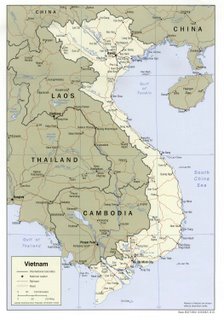
Vietnam says so here:
Vietnam has released four Cambodian Sea Border Patrol officials arrested in disputed waters and accused of piracy, the Vietnamese coast guard said Friday. The four Cambodians were released late Thursday night on orders from the central Vietnam government, after confirming they were members of Cambodia's border patrol.Background info here.
But a Vietnamese official said the incident at sea on Thursday raises new questions about a series of pirate attacks on Vietnamese fishing boats.
"I think that these Cambodian coast guards were the ones thought to have been pirates who raided many Vietnamese fishing vessels before," said Nguyen Kim Hong, deputy commander of Vietnam's Southern Regional Coast Guard.
Thursday, August 24, 2006
Cover blown on satellite work
Well, in case the Iranians hadn't figured it out for themselves, some blabbermouths have revealed a success story in spotting weapons transfers to our Iranian friends:
UPDATE: The operational end of the process set out here.
In the closed world of spy satellite photo analysis, it's called "crate-ology": the science of identifying a weapon or some other key component by the size and shape of its box.I guess the process will now be moved indoors or under other cover because the idiots "not authorized to discuss the incident" couldn't keep their yaps shut and USA Today couldn't help itself in revealing the process.
The technique came into play last month when a U.S. spy satellite, looking down on an Iranian air base, captured images of military crews loading what U.S. intelligence analysts concluded were eight C-802 Noor anti-ship cruise missiles on board a transport plane, according to intelligence officials.
The episode was detailed by one U.S. intelligence official who saw a report on the incident. It was confirmed by a U.S. official from a second intelligence agency and by a diplomat with a foreign government. They did not want their names used because they were not authorized to discuss the incident.
UPDATE: The operational end of the process set out here.
The illusion of security: Transportation Worker ID plan scuttled
The concept of biometric ID cards for port workers and merchant ship crew seems to be too hard to implement, as reported here:
The Department of Homeland Security quietly announced this week that port facility and merchant vessel owners and operators will not be required to install readers for the biometric ID cards it plans to issue to the nation's transportation workers.Here's an idea for a temporary fix: Gate guards and photo IDs. A quarterdeck guard. Locked spaces on ships with cypher locks. You know, kinda like we've been doing in the Navy for some time.
The change, which critics says guts the security benefit of the proposal, is the latest stumble for the controversial ID card project, called the Transportation Worker Identity Credential, or TWIC program.
Officials "have concluded that facility and vessel owners and operators will not be required to purchase or install card readers during the first phase of the TWIC implementation," reads a notice in the Federal Register published Monday.
The notice also promises that "a requirement to purchase and install card readers will not be implemented until the public is afforded further opportunity to comment on that aspect of the ... program." It adds that "the details of this approach will be explained in the next rulemaking."
The TWIC program, mandated by Congress in the 2002 Maritime Transportation Security Act, is designed eventually to cover 725,000 airport workers, truck drivers, merchant seafarers and others needing unescorted access to transportation facilities like ships, ports and runways.
Workers requiring the card will have to submit their fingerprints and undergo a criminal record, terrorism watch-list and immigration status background check. They will have to travel twice to one of the 125 issuing stations homeland security intends to set up around the country -- once to apply and once to pick the card up -- and pay around $150.
But progress has been slow and marred by concerns about cost, the security of the card-issuance process, and how workers wrongly refused a card will be able to get redress.
***
But labor unions protested that using the credential as a "flash card" -- one that is simply shown to a guard, rather than confirming the holder's identity through biometrics or a PIN number -- would give a false sense of security and increase the ease with which criminal or terrorist gangs could infiltrate transportation facilities by posing as credentialed workers.
"Why should workers bear the brunt of our government's transportation security programs?" asked Edward Wytkind, president of the Transportation Trades Department of the AFL-CIO in a statement.
"It makes no sense to impose onerous requirements on workers now and force them to pay almost $150 for a glorified flash pass that may never be used as intended," Wytkind said.
Hamilton said the biometric industry shared that concern about moving ahead with the credential issuance process before resolving key technological issues regarding the readers.
"Will these cards have to be modified or re-issued at a later date" if it turns out that the readers chosen are not compatible? he asked.
"It is unfortunate that they didn't think these issues through before" issuing the proposed rule, he said.
Mogadishu port reopens - Somalia still a mess
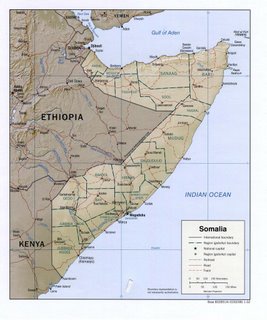
Mogadishu, the port, reopens as the Islamist "rulers" invoke memories of trains running on time. And the pirate port has been taken over. All reported here and here respectively.
In the meantime, Puntland and Ethiopia may or may not have troops in Somalia, drawing threats from the Islamists:
Somaliland remains independent.
The spokesperson for the Islamic Courts Council said on Wednesday that
the presence of Ethiopian and Puntland troops in central Somalia regions to aid warlord Abdi Qeibdid must not be tolerated.
Sheikh Abdirahim Ali Mudey, the ICC's information secretary, said the Islamists spared Colonel Abdi Qeibdid's life after Islamist militiamen defeated him in Mogadishu.
This is the first time the Islamists have shed light on exactly how Qeibdid left Mogadishu after his defenses were overran by the Islamists.
Sheikh Mudey said the ICC leadership talked with Puntland president Mohamud "Adde" Muse and the two sides agreed that Puntland would not cross into south Mudug region and the ICC promised to not enter Puntland-controlled areas.
"We will send our forces into Puntland regions if Puntland forces do not rereat from south Mudug," the ICC's information secretary warned.
Puntland sent hundreds of militias Wednesday to Bandiiradley village, which is located some 60 KM south of Galkayo, the capital of Mudug region.
Bill Roggio has much more on the other fun things unfolding in Somalia ("slide into the darkness of a radical Islamist state") here at the Counterterrorism Blog.
More on the Somali pirates here.
Fishermen turn tables on Greenpeace

Greenpeace gets a dose of its own medicine as reported here:
The arrival of Greenpeace’s flagship sparked a blockade by angry French tuna fisherman, a legal row and a veiled threat of violence if Greenpeace tried to remain in the waters off Marseilles for more than a few hours.What is that whining noise?
As Rainbow Warrior II approached the port to highlight what campaigners say is the destruction of the bluefin tuna population, at least 21 fishing boats surrounded her.
“This is an illegal act, breaking several laws,” Pierre Ramel, Greenpeace director of campaigns, said. Opponents pointed out that Greenpeace had used similar tactics before.
Wednesday, August 23, 2006
Russian tanker seized by Guinea

Reported here:
A Russian tanker and its 20-man crew has been seized by authorities in Guinea after being accused of entering a closed economic zone, said officials on Tuesday.More details:
Authorities in Guinea have dropped all charges against the captain of a Russian tanker that was detained in the country's economic zone, a Russian shipping company said Wednesday.
Ten armed men wearing the back uniforms of the Guinean Navy boarded the Luchegorsk tanker Tuesday and told the captain that it had illegally entered another country's economic zone.
Andrei Sychev, deputy general director of the Primorye Shipping Company, which owns the tanker, said the captain proved that at the moment of detention the vessel was in the economic zone of a neighboring state - Sierra Leone.
"The Guinean authorities have dropped all claims against the Luchegorsk's captain. The crew of the vessel, which is registered at the port of Nakhodka [in Russia's Far East], has all essential provisions," he said.
But he said the Guinean authorities had claimed the Swiss company that had leased the tanker had been engaged in illegal operations supplying fuel and water to vessels working in the country's territorial waters.
"The company will probably have to pay a fine for illegal operations in Guinean territorial waters. After this, the Luchegorsk will be allowed to leave the port of Conakry, where it is currently under arrest. This could happen Wednesday or Thursday," he said.
Tuesday, August 22, 2006
Commercial dispute spooling out of control off Iran
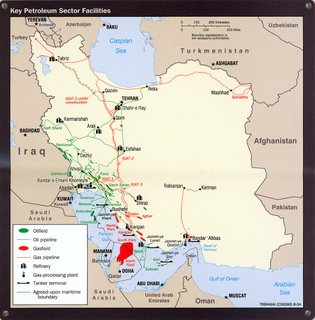
One more reason not to do business with "government" oil companies found in this piece Iranian troops fire on Romanian oil rig:
Romania said Iranian troops opened fire from a warship and seized a Romanian oil rig Tuesday off the coast of Iran, holding its workers in an incident stemming from a commercial dispute.International law of arrest of sea-going vessels here.
Sergiu Medar, a national security adviser to Romanian President Traian Basescu, said the seizure resulted from a commercial dispute Iran is treating "in an extreme way." He gave no details.
UPDATE: Some background info (from 8/17/06) here:
Grup Servicii Petroliere s.a (GSP), a Romanian drilling and oilfield services company today accused Petro Iran Development Co (PEDCO), a subsidiary of state-owned National Iranian Oil Co. (NIOC) of violating international norms by holding hostage one of its rigs and crew in Iranian waters despite court orders to the contrary.and more here:
The Constanta-based company, part of the Upetrom Group Management Limited which employs some 4,000 staff with 98 years experience in manufacturing oilfield equipment, said two of its rigs – Fortuna and Orizont – were held hostage in the Iranian waters despite the termination of contract four months ago.
“This is a complete violation of human rights as the rigs and its crew was moored in the Iranian waters even after the termination of contract,” said Mr. Gabriel Comanescu, President of GSP.
“As a gesture of goodwill GSP allowed the rigs to continue its work schedule for three months since the date of termination of contract on April 1st , 2006 in order to secure the well,” he said.
“We have managed to arrange the necessary clearance for the boats to take out one of the rigs – Fortuna - based on a court decree from Queshm and an implementation order from Hengam Island security forces hand delivered to PEDCO, but the other rig along with Romanian crew is yet to be released though there is a court order issued three months ago from Kish Court,” he said.
Analysts said this looked like a rare case and much depends on the conditions of the charter party.*I doubt this will make it easier for Iran to find rig owners willing to role the dice on Iranian justice.
"It is the first time we are hearing of a rig-related case. Provided the conditions of the charter party were complied with, the rig owner is entitled to take it away on expiry of the contract and the Iranians would have little comeback on this," said Frank Kennedy, a maritime consultant in Dubai.
"But if the charter conditions were not complied with, then there will be repercussions," Kennedy said. "We don't know the clauses of the contract and cannot comment further."
Another Dubai analyst said due to political risks many companies were unwilling to extend contracts with Iranian companies.
"I think there are few international rigs operational in Iran despite the many tenders coming out," the analyst said.
*Charter party defined.
UPDATE2: Added map. Click on it to make it bigger.
UPDATE3: (8/23/06) Another update from Platt's here:
GSP said it had every right to take back possession of the rig after theSounds like both sides might have been bitten by "Oriental Oil."
contract with Oriental Oil was terminated, and added that it had since
discovered "that the Dubai-based company had never existed and it was never
registered with the Dubai Chamber of Commerce and Industry."
Last week, Iranian energy news agency Shana reported that Petroiran had
called on the UAE to help with returning the Fortuna rig, which it said had
been "hijacked from Iranian waters."
Petroiran managing director Mostafa Khoee was quoted saying the rig was
under rental contract to Oriental Oil for two years and that the rig was still
at Iran's disposal.
However, "a vessel that was on its way to Fujairah has illegally entered
waters of Iran's Hangam gas field and carried the oil rig out of Iranian
waters," Khoee said. "Petroiran will follow the matter through legal
measures," he was quoted as saying at the time.
Hangam is located in the Strait of Hormuz, 20 kilometers off Qeshm island
in the Gulf. The field is jointly shared with Oman. The development of Hangam
has been delayed because drilling equipment to spud appraisal wells was not
procured on time. At the moment, only four foreign rigs are active in Iran's
oil sector.
UPDATE4: More allegations from the Romanian view here.
UPDATE5: Rig returned by Iran? Says so here.
UPDATE6: Iran's foreign minister says it'a all a big lie:
Foreign Ministry spokesman Hamid-Reza Asefi Tuesday rejected reports on seizure by Iran of a drilling oil rig in the Persian Gulf belonging to a Romanian company.
"These reports are part of media misinformation and are false," said Asefi.
Skipper of USS Cole during al Qaeda attack deselected for promotion

CDR Lippold takes another hit. Let this be a lesson to young officers. See also Kimmel, Husband E.
More on Cole attack here.
Earlier post on CDR Lippold here.
Japan & ASEAN meet on preventing maritime terrorism
Reported here
:
:
Japan and five Southeast Asian countries on Tuesday opened a three-day maritime security meeting aimed at preventing terrorism in the region, officials said.
Officials from Japan, Indonesia, Malaysia, the Philippines, Singapore and Thailand gathered in Tokyo for the three-day seminar, Japanese Coast Guard official Minoru Kaneda said.
The naval police and coast guard officials were to exchange information on terrorism at sea and discuss measures to prevent any attacks, the Coast Guard said in a statement.
Monday, August 21, 2006
Maritime Monday 23 is posted
Visity Fred Fry International: Maritime Monday 23 for a week's worth of international maritime news, gathered at no cost to you for your reading pleasure!
Seattle team wins first cross-Atlantic rowing race

Reported here:
Today (Friday 18 August 2006), four men from Seattle, USA in their boat, the James Robert Hanssen became the first crew in the Shepherd Ocean Fours Rowing Race 2006 to triumphantly cross the finish line, ending a voyage of the most epic proportions.More info here. Initial report here.
Sixty nine days previously, four courageous teams of four set off from New York Harbour, USA to embark on a unique adventure, to row 2,863 nautical miles across the North Atlantic Ocean to Falmouth, UK, in the worlds first ever North Atlantic Ocean Rowing Race. Competing on equal terms in purposely designed and built 29ft long ocean rowing boats known as the Woodvale Fours class, the teams have been racing against each other to be the first to cross the finish line, in the fastest possible time.
With an impressive lead of over 250 nautical miles, Boat #2 – James Robert Hanssen crewed by four university friends from Seattle, USA – Jordan Hanssen, Dylan Le Valley, Greg Spooner and Brad Vickers crossed the race finish line, a line of longitude from Bishop Rock Lighthouse (at 06 26.74W), today at 1444 hours GMT (1544 Hours BST) in a total crossing time of 69 days, 23 hours and 18 minutes.
Crew Member, Greg Spooner comments from the boat:
“This has been an amazing experience for us and we are all very emotional at the moment. This project has involved many more people than just the four of us and we are incredibly grateful for all the support of our family and friends”.
Death at sea: Overloaded people smuggling boat flips, killing 10+
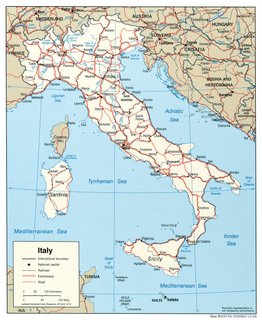
Reported here:
At least 10 people died and as many as 40 were feared missing when a small boat packed with illegal immigrants sank off Sicily on Saturday, prompting Italy to call for greater cooperation to fight human trafficking.At least one article reports an effort to try to pin the "wreck" on the Italian Navy here:
"What happened today is not only a tragedy but nothing less than a crime," Interior Minister Giuliano Amato said in a statement. "And if we don't manage to punish crimes they repeat themselves and tragedies repeat themselves too."
The boat, a 10-metre-long wooden vessel believed to have left from Libya, sank at about 3:30 a.m. (0030 GMT) around 10 miles (16 km) off the southern island of Lampedusa.
Coastguard officials said 70 people had been rescued and 10 bodies, including four women, had been recovered.
Survivors reported there had been up to 120 immigrants on board. Such estimates could be inexact so it was difficult to estimate how many were missing, officials said.
Lampedusa, between Sicily and Libya, has become a gateway for illegal immigrants and refugees who leave north Africa in an attempt to enter the European Union.
Police later identified five men among the survivors who they suspected were part of a gang that organised the voyage. The men were believed to be Libyan, police said.
One navy ship had been following the immigrant boat and was able to start the rescue quickly, hence the high number of survivors, the coastguard said.
Survivors said the boat turned over when the immigrants saw the Navy vessel and many of them moved abruptly to one side.
Prosecutors were probing whether an Italian Navy ship may have caused a boat crammed with African migrants off southern Italy to sink, leaving at least 10 people dead and around 40 missing, ANSA news agency said.Look, no matter whether the Italian Navy was visible to the human cargo, the fault lies with the smugglers who overloaded the boat and created a situation in which the would-be immigrants were put in danger.
The prosecutor's office on the southern island of Sicily said it was launching an investigation into whether an attempt to rescue the migrants from their overloaded craft may have caused it to overturn.
Hanging would be too kind for them.
Sunday, August 20, 2006
Sunday Ship History: The German cruisers that changed the world

On August 10, 1914, the German battle cruiser Goeben successfully completed her escape from the British Navy and anchored in Turkish waters as reported here. The dramatic escape that began on August 4, 1914, had ramifications that are with us today. In her remarkable work, The Guns of August, Barbara Tuchman devotes a chapter to this ship, stating, "No other single exploit of the war cast so long a shadow upon the world as the voyage accomplished by their commander during the next seven days."
At the time, Turkey was neutral and having a hard time deciding a side. "Fearing Russia, resenting England, mistrusting Germany, they could not decide." Tuchman writes.
In July 1914, with a two-front looming before them, the Germans suddenly became anxious to secure the ally who could close the Black Sea exit and cut Russia off from her allies and their supplies."England did itself no favors in its relations with the Turks- "While they [Turkey] were hesitating England helpfully gave them a push by seizing two Turkish battleships then being built under contract in British yards." Turkey was most unhappy but still was not completely commited to a German alliance.
In the run up to war, the French were concerned about transporting their troops from France's North African colonies to France across the Mediterranean...And the the two German cruisers in the Med, the Goeben and the Breslau were perceived as threats. The German ships moved to attack Algeria but before major harm was done, received orders to move to Constantinople (now Istanbul). They were now pursued by British battle cruisers.
The race was on.
The Germans won by arriving Dardenelles on August 10 where the Turks invited them in. As Tuchman puts it:
At nine o'clock that evening, August 10, the Goeben and Breslau entered the Dardenelles, bringing, as long afterward Churchill somberly acknowledged, "more slaughter, more misery and more ruin than has ever before been borne within the compass of a ship."Shortly after their arrival, the Turks asked that the ships be disarmed, the Germans refused. Then the ships were announced to have been "sold" to the Turks seemingly as replacements for the two battleships seized by the British. The Turkish public loved it and the Germans became very popular in Turkey.

Turkey still remained neutral, though it began making demands to maintain that neutrality. Even Russia was willing to give up the idea of capturing the Dardenelles for the benefit of keeping Turkey out of the war. But...despite some sabre rattling by Churchill, Lord Kitchener vetoed a torpedo boat attack, on the ground, "England could not afford to alienate the Moslems by taking the offensive against Turkey."
Then the ships, still under German command but with some Turkish warships in company, sailed into the Black Sea and attacked the Russian port of Odessa and a couple of more places for good measure. The Goeben sailed back into the waters splitting Constantiople, a nice move that effectively prevented Turkey from disavowing the atack on Russia- because the seats of power of the Turkish government were now within the range of the cruiser's guns. Russia declared war on Turkey and was joined by its allies.
The closure of the Black Sea precluded easy resupply of Russia. "With the Black Sea closed, her exports dropped by 98 per cent and her imports by 95 per cent."
But the longer term consequences of the Goeben's cruise are felt today:
The cutting off of Russia with all its consequences, the vain and sanguinary tragedy of Gallipoli, the divsion of Allied strength in the campaigns of Mesopotemia, Suez, and Palestine, the ultimate breakup of the Ottoman Empire, the subsequent history of the Middle East, followed from the voyage of the GoebenAt the start of the World War I, the Ottoman Empire controlled most of the Middle East, including Palestine. In 1917, Britain offered up the Balfour Declaration,
...[W]hich promised to help establish a national home for the Jewish people in Palestine. Great Britain was given a mandate of Palestine in 1920 by the League of Nations, in part to implement the Balfour Declaration.We all know how that promise has been playing out over the past 89 years...

A couple of ships, a narrow escape, and a world changed forever.
UPDATE: Bloody Gallipoli.
Saturday, August 19, 2006
U.S.Coast Guard: Training the world in Port Security

Part of the Global War on Terror that tends to go underreported - the training of allies, as set out here in a piece on the graduates of the U.S. Coast Guard's International Maritime Officers Course:
For 10 weeks, each student shares experiences of maritime operations from their region of the world and learns the basics of the U.S. Coast Guard.Exactly right - a lesson well learned.
The class that graduated Friday included 21 students from 20 countries: Albania, Bangladesh, Chile, Colombia, Republic of the Congo, Fiji, Gabon, Georgia, Ghana, Haiti, Indonesia, Jamaica, Kenya, Lithuania, Maldives, Mozambique, Romania, Sri Lanka, Tonga and Uruguay.
They trained in maritime law enforcement, a mission of greater importance today with the threat of terrorism and piracy.
They learn to become better leaders, better planners.
"In our country, we plan after the action happens," said Capt. Cassiano Horacio Rihiva of Mozambique. "We respond after the action happens. We should now plan before the action happens."
***
One nation's choices, Ewalt said during her address to the graduates, can have regional and global effects.
Mboussi, the student from the Republic of the Congo, pointed to the requirements that ships must meet to enter U.S. ports as one example. Countries worldwide would benefit from enacting those standards, Mboussi said.
He said, "Port security doesn't start or end with one country."
Disarming Hezbollah- not on the French watch
John Rosenthal at Transatlantic Intelligencer has the words of the French Foriegn Minister here:
Further on in the interview, Douste-Blazy adds:You know, that might explain the 200 "additional" troops... they aren't planning to do anything, to anyone, anyhow.
We are in agreement about the objective: the disarmament [of Hezbollah], but for us the means are purely political. That is a French specificity.
Douste-Blazy did not elaborate on just what "political means" France intends to bring to bear to disarm Hezbollah, nor when.
Lebanon and China


An interesting read from The Jamestown Foundation Silent Partner: China and the Lebanon Crisis. More information on the C-802 anti-ship cruise missiles fired by Hezbollah:
On July 14, just two days after the conflict erupted, an Anti-Ship Cruise Missile (ASCM) launched from the coast of Lebanon hit an Israeli Hanit (Spear) Sa’ar 5 corvette, an anti-aircraft warfare ship that is said to be the best in its class. Not fatally damaged, the vessel managed to return to active service after a couple of weeks of repairs, but four servicemen were killed in the fire caused by the hit. A second missile hit an Egyptian merchant ship. Positively identified by its electronic signature as a Chinese-made C-802, the existence of such a missile in Hezbollah’s arsenal had been unknown to Israeli intelligence. Designated in China as the YJ (Yingji)-8 (or 82), around 60 to 75 (some say 125) C-802s had been delivered to Iran by 1997. Several of them subsequently found their way into Hezbollah hands. In addition, Arab sources have reported that Iran had supplied Hezbollah with Chinese-made Houdong fast-attack crafts (al-Sharq al-Awsat, July 29) as well as with Chinese-made multiple barrel rocket launchers, including the 12-tube Type 63 (also known as the Fajr-1) and the WS-1/WS-1B, which was redesigned by Iran as the Fajr-5 (Strategic Update, July).Information on the Houdong fast attack boats here. Info on the C-801/802 Chinese missiles here.
***
Considered one of the best ASCMs in the world, the C-802 carries a 165 kg time-delayed semi-armor-piercing high explosive warhead to a range of 120 km at Mach 0.9 speed and at an altitude of 5-7 meters above the sea. It has a 0.75 single-shot hit probability, and under ideal conditions, could have, according to some sources, 0.98. Conditions for hitting Israeli vessels opposite the Lebanese coast were more than ideal. On the night of July 14, when the soldiers where busy preparing for the Sabbath, the vessel’s CIWS (Close-in Weapon System) was most likely not set in auto-engage; given their lack of intelligence, as they were not expecting any ASCM attacks. Moreover, the vessel was located about 16 kilometers away from the coast, giving them, at Mach 0.9 speed, approximately 55 seconds to respond if the missile was immediately detected upon launch. In reality, however, because the C-802 flew at such a low altitude and because its radar was activated only close to the target, the crew had no more than 20 seconds to react. The first C-802 hit but failed to sink the vessel. The second missed another Israeli vessel and instead sank an Egyptian freighter. Three more C-802s were fired on August 1, China’s Army Day, against Israeli Navy vessels—all missed. A PLA study of the missile’s performance is probably already under way.
Lots more on China's ambivalent role...
H/T: Simon World.
Friday, August 18, 2006
A link? Tehran satellite TV outage and August 22?
See here and here.
UPDATE: Should we be singing?
UPDATE: Should we be singing?
Six o'clock - TV hour. Don't get caught in foreign towers.
Slash and burn, return, listen to yourself churn.
Locking in, uniforming, book burning, blood letting.
Every motive escalate. Automotive incinerate.
Light a candle, light a votive. Step down, step down.
Watch your heel crush, crushed, uh-oh, this means no fear cavalier.
Renegade steer clear!
A tournament, tournament, a tournament of lies.
Offer me solutions, offer me alternatives and I decline.
It's the end of the world as we know it.
It's the end of the world as we know it.
It's the end of the world as we know it and I feel fine.
Gasoline prices: Adjusted for inflation

Chart of the Day says:
Over the last 24 weeks, the average US price for a gallon of unleaded has increased 65 cents per gallon and is near the 25-year high made last year in the wake of Hurricane Katrina. However, when adjusted for inflation, it is clear that gasoline prices still have a touch more to go before they reach the inflation-adjusted peak of $3.25 that occurred back in 1981. Stay tuned...Interesting thoughts here:
One part of our fuel bill has increased dramatically in real terms over the years: Taxes. Adjusted for inflation, state and federal taxes on gasoline have increased by 868 percent since 1922 — they were only 4 cents per gallon back then — and by 50 percent since 1981, when they were just 14.5 cents.And a really good point about a "necessity":
But even with the recent rise in gas prices, gasoline prices are rising at a slower rate than many other necessities.
A half-gallon of milk, for example, has increased from an average of $1.12 in 1981 to $2.09 last month. While milk prices have increased at a slower pace than inflation, they've increased at a faster rate than gasoline prices. Milk prices declined in real terms by around 18.6 percent, perhaps aided by federal government subsidies that the Progressive Policy Institute says amounts to $3.32 for each of America's 9 million dairy cows, while gasoline declined by a slightly more robust 18.9 percent. Where are the critics of Big Dairy?
Bread prices also have increased relative to gasoline since 1981. The price for a pound of white bread has increased by 103 percent — about 8 percent less than the inflation rate over the period. Where are the calls for a windfall profits tax on the makers of Wonder Bread?
Moreover, the price of a first-class postage stamp has risen from 18 cents in 1981 to 39 cents today — almost precisely keeping pace with the inflation rate.
One needn't consult consumer price indexes to understand that gasoline isn't significantly overpriced. Consider, for example, how many Americans willingly pay $1 or even $1.50 for a 20-ounce bottle of drinking water. At $1, the price of that water is $6.40 per gallon — nearly 2.8 times the amount Americans paid for a gallon of gasoline last month.Heh.
UPDATE: Some state go out of their way to stick it to their residents. For example, check the North Carolina gasoline tax:
North Carolina: 30.15 cents per gallonNew York is 31.9 cents per gallon. Wisconsin is 32.1 cents per gallon. Federal gasoline tax is 18.4 cent per gallon. (source)
South Carolina: 16 cents per gallon
Georgia: 7.5 cents per gallon
Virginia: 17.5 cents per gallon
North Korea" "Agrees" to accept food aid
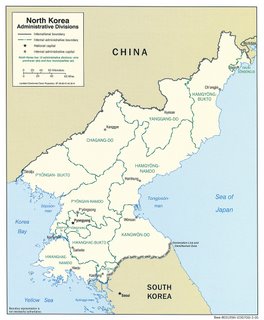

While it may or may not soon test a nuclear weapon, North Korea's huddled masses rely on the outside world to feed them, as reported here:
The UN food agency says North Korea has agreed to accept emergency food aid in the wake of heavy flooding in July.Kim the Whacky World Leader is doing a fine job....
***
North Korea is secretive about releasing details of accidents or natural disasters, making any confirmation of the extent of the flooding difficult.
But Pyongyang has cancelled a mass gymnastics display, called Arirang, which is a key source of income for the nation, to focus, it says, on recovering from the floods.
North Korea is already reliant on foreign donations to feed its people.
The WFP began working in the country in the mid 1990s, after about two million people died from famine.
Cougar Ace update: Upright and ready for tow

You remember the COugar Ace, the car carrierin distress off Alaska? Now, as reported here, things are looking better:
Mitsui O.S.K. Lines, Ltd. has reported that the MOL-operated car carrier Cougar Ace, which was disabled at sea, south of the Aleutian Islands on Monday, July 24, and is now moored at Dutch Harbor in the Aleutian Islands, has been restored to a nearly upright position. This completely eliminated threat of submergence and the vessel is now moored safely.
Unified Command coverage here. Lots more photos there. From te latest incident report:
On Tuesday, August 15, 2006, the USCG Marine Safety Detachment (MSD) in Dutch Harbor reported that the Cougar Ace list is currently at 12 degrees and vessel stable. The owners, Mitsui OSK Lines, and Titan are conducting soundings of all tanks to verify the vessel stability in order for Titan, the contracted salvor, to return operation of the vessel to Mitsui OSK Lines.
The vessel’s emergency generator is on line and the service generator is being considered for placing back on line once Titan releases the ship back to the owners. The owners plan to clean transmission fluid and lubricants from all the car decks and containerize the recovered fluids for proper disposal. MSD personnel reported that most decks suffered vehicle damage and all vehicles must be re-secured. MSD also reported the water, sewage systems, fire main and low pressure CO2 systems are inoperable and will be evaluated for repairs by the owner.
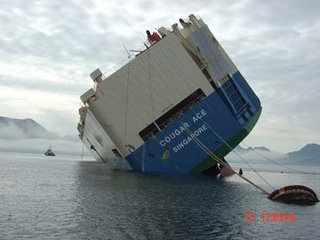 Bottom photo: Cougar Ace, stern view. (8/13/2006)Date: 8/14/2006
Bottom photo: Cougar Ace, stern view. (8/13/2006)Date: 8/14/2006Photo Credit: ADEC -- J. Brown
Thursday, August 17, 2006
A couple of big oil spills
Reported here:
A Japanese tanker spilled about 1.4 million gallons of crude oil in the eastern Indian Ocean following a collision with a cargo ship, the tanker's operator said Tuesday. Japan's Kyodo news service said the spill - which would be about 4,500 tons - may have been the largest ever involving a Japanese tanker.The second spill is a bad one:
In a separate oil spill, the Philippines said that a tanker had sunk in rough seas Friday off the coast of Guimaras Island, about 312 miles southeast of Manila. About 528,000 gallons of industrial fuel was leaking from the accident, officials said.
A central Philippine island province declared a ``state of calamity'' following what authorities called the country's worst spill.
The Philippines on Wednesday appealed for international help in battling the country's worst-ever oil spill.(source)
Tanker Solar 1 spilled more than 2 million litres of industrial fuel when it sank last week, polluting a major marine reserve and threatening the livelihoods of thousands of fishermen, the coastguard said.
Officials have warned that the spill, the largest to afflict country, could take three years to clean with over 200 kilometres of coastline affected. The Philippines on Wednesday appealed for international help in battling the country's worst-ever oil spill.
Tanker Solar 1 spilled more than 2 million litres of industrial fuel when it sank last week, polluting a major marine reserve and threatening the livelihoods of thousands of fishermen, the coastguard said.
Officials have warned that the spill, the largest to afflict country, could take three years to clean with over 200 kilometres of coastline affected.
***
Fishing grounds, dive spots and a national marine reserve were contaminated. The provincial government has declared the tropical resort island a disaster zone.
The local government has said the livelihoods of around 15,000 people, many of them fishermen, had been hit by the disaster.
Latest ONI Worldwide Threat to Shipping Report (to 16 August 2006)
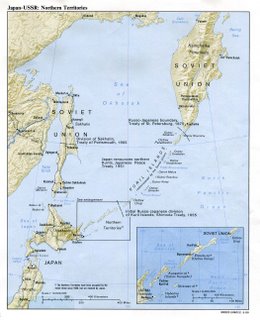
Latest Office of Naval Intelligence Worldwide Threat to Shipping information found here. Highlights:
1. SOMALIA: Somalia’s Union of Islamic Courts (UIC) seized control of Harardhere, per 13 Aug reporting. The central township near the coastline has been a base of piracy and dozens ofMore on the Russian-Japanese spat here and here. The latter link also refers to a Taiwan-Japanese dispute over another set of islands, the Senkaku Islands.
hijackings of ships in the Indian Ocean. Islamic courts official Sheikh Said Ali told reporters that the Islamic Courts are in full control of Harardhere. He claimed the era of banditry and piracy was over and the actions of pirates were unlawful, unacceptable,
and un-Islamic. Ali warned that anybody suspected of aiding pirates or being among them will be punished according to Sharia law. Residents of Harardhere said the pirates, calling themselves the Defenders of Somali Territorial Waters and loyal to regional warlord Abdi Mohamed Afweyne, fled before the Islamic militiamen
battlewagons arrived...
***
1. GULF OF OMAN: Containership reported suspicious approach 12 Aug at 0830 local time while underway in the Gulf of Oman, approximately 25 NM South of the Iranian coast. Ten to twelve individuals in a wooden hulled (brown) boat with white superstructure approached the containership. A man was on top of the superstructure waving a cloth. Master took evasive maneuvers to avoid the approaching boat. Suspicious boat increased speed (12-14 kts) and tried to approach the vessel despite vessel’s attempts to avoid close approach. Master raised alarm and crew mustered and activated fire hoses. After 15 minutes, suspicious vessel altered course and left the area (Operator, IMB).
***
2. INDONESIA/PAPUA NEW GUINEA: Indonesian Papua province fisherman shot dead 08 Aug by Papua New Guinea (PNG) military off Jayapura near the border betweenIndonesia and Papua New Guinea. Indonesian authorities claim the incident occurred in Indonesian territorial waters while PNG authorities claim the incident occurred in PNG territorial waters. Both governments are working to investigate the details of the incident. ONI Comment: Unfortunately, accidental casualties are often incurred in areas where fishing rights are in question (Hong Kong AFP, ONI).
***
1. JAPAN/RUSSIA: Japanese fishing vessel (KISSHIN MARU No 31) was fired on by a Russian coast guard patrol boat 16 Aug near Kaigara islands, northeast of Hokkaido, Japan. One fisherman was fatally shot. Russian authorities have sized the vessel, which reportedly failed to obey orders to stop. Japanese Coast Guard authorities dispatched two patrol boats to the scene following the incident. Both governments are working to investigate the details of the incident. Kaigara island is reportedly administered by Russia and claimed by Japan. ONI Comment: Unfortunately, accidental casualties are often incurred in areas where fishing
rights are in question (AFP, LM).
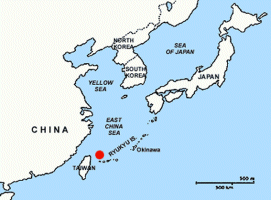
 UPDATE: Russians give back a body, keep the fishing boat as reported here.
UPDATE: Russians give back a body, keep the fishing boat as reported here.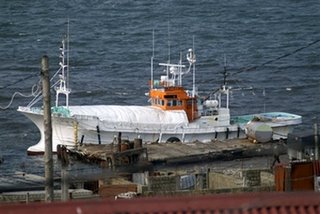
New Rand report on Nuke port blast

Reported as Rand: Port Blast Would Be Devastating.
You know, a nuke going off near any populated area will do the same or worse damage. I'm not sure where the news is here.
UPDATE: As long as we're working "port security", I suggest looking at this:
A new study of U.S. seaport security delivers a message that leaders and citizens may not want to hear: Because there is no foolproof way to protect America’s ports from a terrorist attack, current policies and programs need to focus much more on recovery and economic restoration. In a report released today by the Public Policy Institute of California (PPIC), a team of economists and maritime security experts looks at an array of security issues to provide one of the most comprehensive examinations of port security to date.You can download the Public Policy Institute of California report "Protecting the Nation's Seaports: Balancing Security and Cost" here. And the complete Rand report "Considering the Effects of a Catastrophic Terrorist Attack" here.
Given that 41 percent of U.S. international trade passes through the nation’s 361 seaports and that millions of American paychecks depend on this flow, how devastating would an attack be to the nation’s economy? The report’s chapters provide a range of estimates: At the high end, some of the authors argue that an attack on a major seaport such as Los Angeles-Long Beach could cost the nation tens of billions of dollars. However – if response and recovery is appropriate and sufficient – other authors find that the economic cost would be relatively small.
***
No matter what we do to protect the ports, it will not be enough to ensure – absolutely – against an attack at some location,” says PPIC program director Jon Haveman, who edited the volume with PPIC research fellow Howard Shatz. One of the report’s strongest recommendations is that comprehensive recovery plans be created specifically to reduce economic panic and to restore global supply chains quickly following a catastrophe. “How well government reacts to the problems caused by an attack is probably as important as how well it anticipates them,” adds Shatz. In fact, the authors also suggest that rigorous recovery plans can serve as a disincentive to terrorists, who have been shown to focus on targets where they can do the most damage—economic and otherwise.
***
[Protective] Measures would include continuing a “layered” defense whereby there are several tracking, screening, and inspection points for shipping containers as they flow from the foreign country’s factory gate, through the maritime domain, to U.S. shores; using multiple technologies such as radiation detectors and container tracking devices; steering government development of new technologies toward areas that the private sector has no incentive to pursue; strengthening emergency response at the nation’s ports; strengthening terrorism insurance markets; and reevaluating the level of overall port security funding and staffing for public entities that focus on port security, such as the U.S. Coast Guard.
Happy reading.
Subscribe to:
Comments (Atom)
